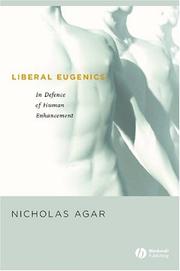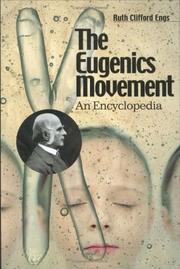| Listing 1 - 10 of 595 | << page >> |
Sort by
|

ISBN: 9781405123907 1405123907 9781405123891 1405123893 Year: 2005 Publisher: Malden (Mass.) : Blackwell,
Abstract | Keywords | Export | Availability | Bookmark
 Loading...
Loading...Choose an application
- Reference Manager
- EndNote
- RefWorks (Direct export to RefWorks)
Book
ISBN: 9780199385904 0199385904 Year: 2017 Publisher: New York: Oxford university press,
Abstract | Keywords | Export | Availability | Bookmark
 Loading...
Loading...Choose an application
- Reference Manager
- EndNote
- RefWorks (Direct export to RefWorks)
Provided from editor : "In 1883, Francis Galton, a cousin of Charles Darwin, coined the word "eugenics" to express his dream of perfecting the human race by applying the laws of genetic heredity. Adapting Darwin's theory of evolution to human society, eugenics soon became a powerful, international movement, committed to using the principles of heredity and statistics to encourage healthy and discourage unhealthy reproduction. Early in the twentieth century and across the world, doctors, social reformers, and politicians turned to the new science of eugenics as a means to improve and strengthen their populations. Eugenics advocates claimed their methods would result in healthier, fitter babies and would dramatically limit human suffering. The reality was a different story. In the name of scientific progress and of human improvement, eugenicists targeted the weak and the sick, triggering coercive legislation on issues as disparate as race, gender, immigration, euthanasia, abortion, sterilization, intelligence, mental illness, and disease control. Nationalists eagerly embraced eugenics as a means to legitimize their countries' superiority and racialized assumptions, and the Nazis notoriously used eugenics to shape their "final solution."

ISBN: 0275958221 Year: 2001 Publisher: Westport (Conn.) : Praeger,
Abstract | Keywords | Export | Availability | Bookmark
 Loading...
Loading...Choose an application
- Reference Manager
- EndNote
- RefWorks (Direct export to RefWorks)
Book
Year: 1934 Publisher: Leipzig : Quelle & Meyer,
Abstract | Keywords | Export | Availability | Bookmark
 Loading...
Loading...Choose an application
- Reference Manager
- EndNote
- RefWorks (Direct export to RefWorks)
Book
ISBN: 2715404026 Year: 2020 Publisher: Paris : Presses Universitaires de France,
Abstract | Keywords | Export | Availability | Bookmark
 Loading...
Loading...Choose an application
- Reference Manager
- EndNote
- RefWorks (Direct export to RefWorks)
Objet de fantasmes et de répulsion, l'eugénisme est associé aussi bien à des projets techno-scientifiques qu'à des idéologies ou des doctrines (darwinisme social, racisme), des utopies futuristes, des mesures relatives à la procréation ou encore à des politiques démographiques.A minima, il est possible de le définir comme la volonté de modifier le patrimoine génétique de l'humanité en vue de son amélioration. Mais adhérer à une telle perspective, n'est-ce pas présupposer l'existence d'une inégalité génétiquement déterminée entre humains ou vouloir créer des élites héréditaires ? Jusqu'où conduit cette entreprise, dont les objectifs oscillent entre normalisation et fabrication du surhumain ?Pierre-André Taguieff décrypte un projet qui connaît un regain d'intérêt avec le transhumanisme et les techniques de procréation médicalement assistées, et qui en dit long sur la propension des hommes à se révolter contre la nature ou à se prendre pour des dieux.

ISBN: 0313327912 Year: 2005 Publisher: Westport (Conn.) Greenwood
Abstract | Keywords | Export | Availability | Bookmark
 Loading...
Loading...Choose an application
- Reference Manager
- EndNote
- RefWorks (Direct export to RefWorks)
An A-to-Z overview of eugenics - one of the most controversial scientific and cultural movements of the last century Eugenics - the theory that we can improve future generations of humans through selective breeding - was one of the most controversial movements of the early 20th century. Often tied to racist beliefs and nativist desires to limit immigration, the eugenics movement attracted some of the most prominent scientists and social reformers of the day. This encyclopedia brings into one place concise descriptions of the leading figures, organizations, events, legislation, publications, concepts, and terms of this vitally important historical movement. Although focused on the United States during the heyday of the movement, the encyclopedia includes material on international events as well as connections to important contemporary issues such as genetic engineering, "family balancing," and the possibility of human cloning. Provides an A-to-Z overview of eugenics--the science of "improving" humans through heredity--one of the most controversial scientific and cultural movements of the last century. The Eugenics Movement covers almost 200 years of history and includes over 250 entries on such topics as: "inherited conditions" such as alcoholism, prostitution, poverty, and criminality that eugenicists thought could be eliminated by following eugenic methods; concepts such as "feeblemindedness," "race degeneracy," and "race suicide" that were pervasive during the era of the eugenics movement; tools that eugenicists relied on, such as laws that allowed forced sterilizations of the "unfit"; organizations that encouraged the "fit" to produce more children; the continued acceptance of attempts to improve future generations through genetic testing and treatment. The book includes photographs, a chronology of events, and an extensive bibliography of works for further information.. Examines a controversial aspect of scientific history. Discusses how contemporary controversies over genetic engineering relate to the eugenics theories of the past.
Book
ISBN: 019988210X 1280835575 9786610835577 019802441X 0195348788 Year: 2002 Publisher: Oxford : Oxford University Press, USA,
Abstract | Keywords | Export | Availability | Bookmark
 Loading...
Loading...Choose an application
- Reference Manager
- EndNote
- RefWorks (Direct export to RefWorks)
When Hitler published Mein Kampf in 1924, he held up a foreign law as a model for his program of racial purification: The U.S. Immigration Restriction Act of 1924, which prohibited the immigration of those with hereditary illnesses and entire ethnic groups. When the Nazis took power in 1933, they installed a program of eugenics--the attempted ""improvement"" of the population through forced sterilization and marriage controls--that consciously drew on the U.S. example. By then, many American states had long had compulsory sterilization laws for ""defectives,"" upheld by the Supreme Court in 19
Book
Year: 1930 Publisher: London Burns, Oates & Washbourne
Abstract | Keywords | Export | Availability | Bookmark
 Loading...
Loading...Choose an application
- Reference Manager
- EndNote
- RefWorks (Direct export to RefWorks)
Book
Year: 1875 Publisher: Oneida, N. Y. Oneida community
Abstract | Keywords | Export | Availability | Bookmark
 Loading...
Loading...Choose an application
- Reference Manager
- EndNote
- RefWorks (Direct export to RefWorks)
Book
Year: 1907 Publisher: London : J M Dent & Sons,
Abstract | Keywords | Export | Availability | Bookmark
 Loading...
Loading...Choose an application
- Reference Manager
- EndNote
- RefWorks (Direct export to RefWorks)
"Since the publication of my work on Hereditary Genius in 1869, I have written numerous memoirs, which are scattered in various publications. They may have appeared desultory when read in the order in which they appeared, but as they had an underlying connection it seems worth while to bring their substance together in logical sequence into a single volume. I have revised, condensed, largely re-written, transposed old matter, and interpolated much that is new; but traces of the fragmentary origin of the work still remain. My general object has been to take note of the varied hereditary faculties of different men, and of the great differences in different families and races, to learn how far history may have shown the practicability of supplanting inefficient human stock by better strains, and to consider whether it might not be our duty to do so by such efforts as may be reasonable, thus exerting ourselves to further the ends of evolution more rapidly and with less distress than if events were left to their own course. The subject is, however, so entangled with collateral considerations that a straightforward step-by-step inquiry did not seem to be the most suitable course. I thought it safer to proceed like the surveyor of a new country, and endeavour to fix in the first instance as truly as I could the position of several cardinal points. The general outline of the results to which I finally arrived became more coherent and clear as this process went on"--Introduction. (PsycINFO Database Record (c) 2005 APA, all rights reserved).
| Listing 1 - 10 of 595 | << page >> |
Sort by
|

 Search
Search Feedback
Feedback About UniCat
About UniCat  Help
Help News
News